Answered step by step
Verified Expert Solution
Question
1 Approved Answer
The business process example starts witha customer filing an online complaint regarding problems with a car that they rented in the past. The customer
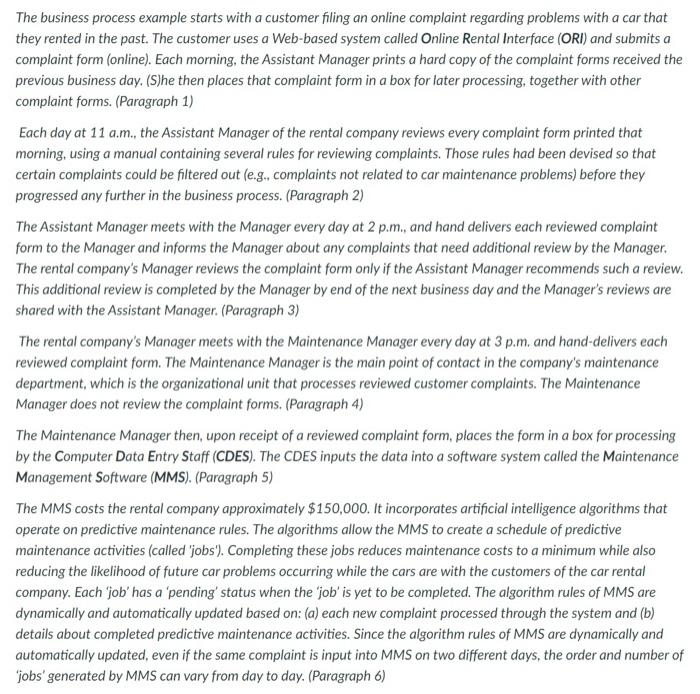
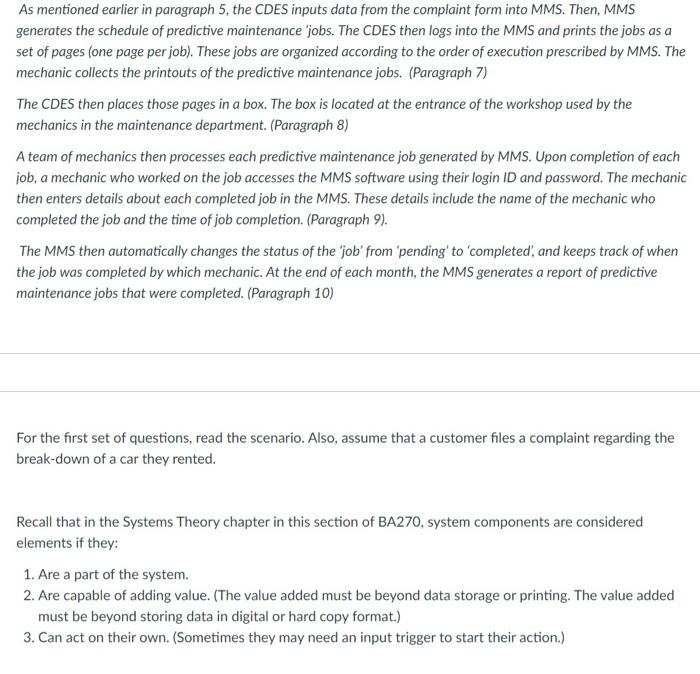
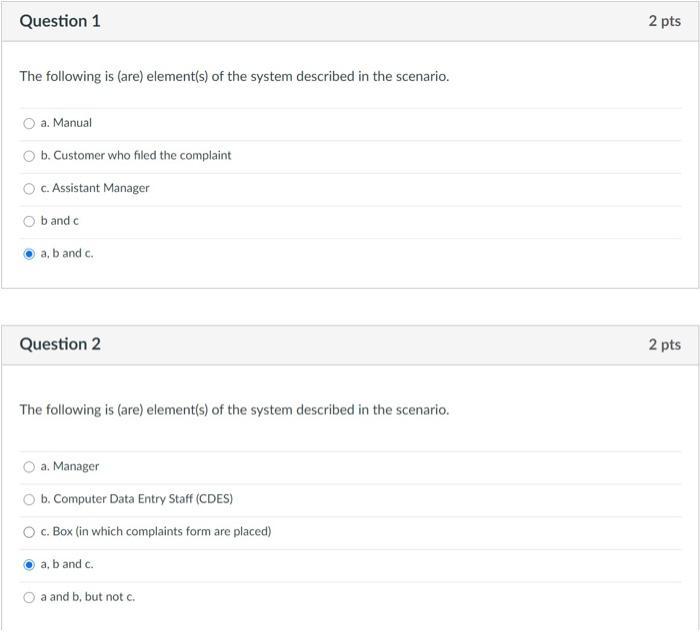
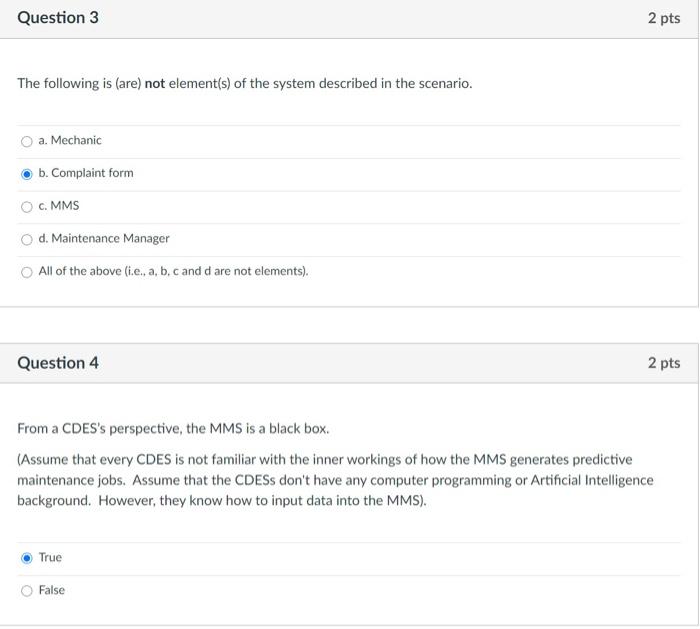
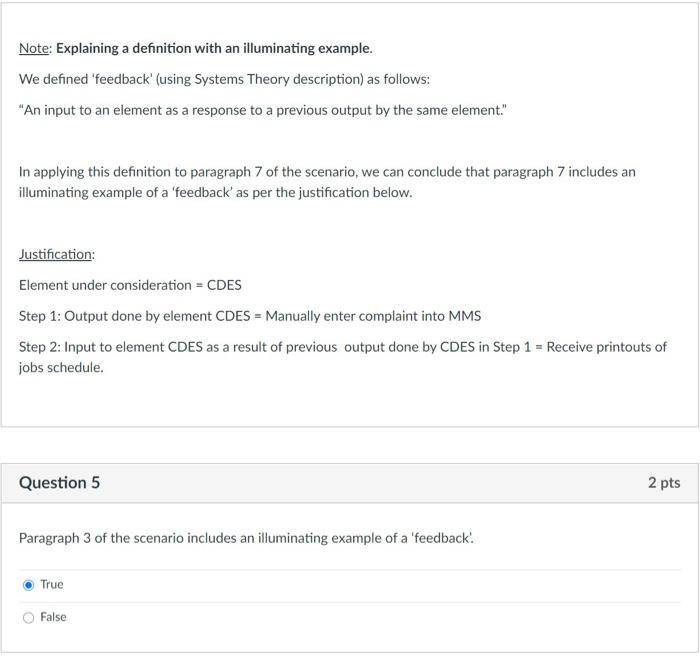
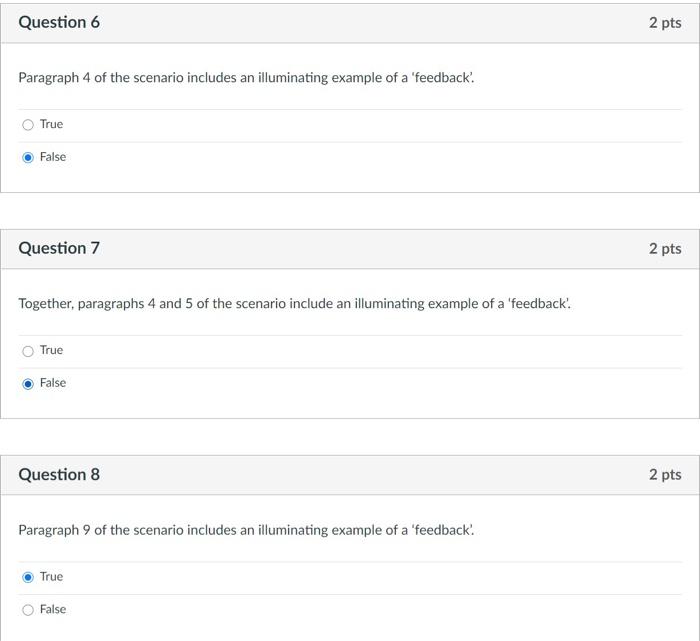
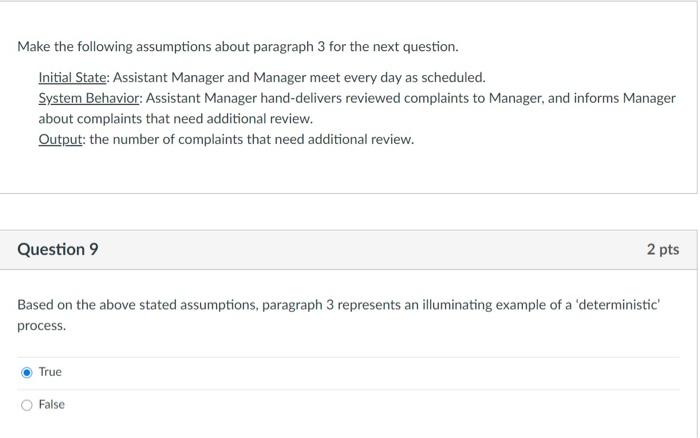
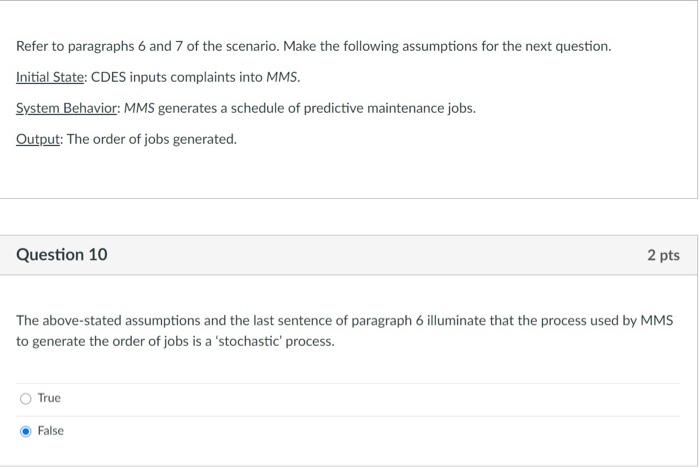
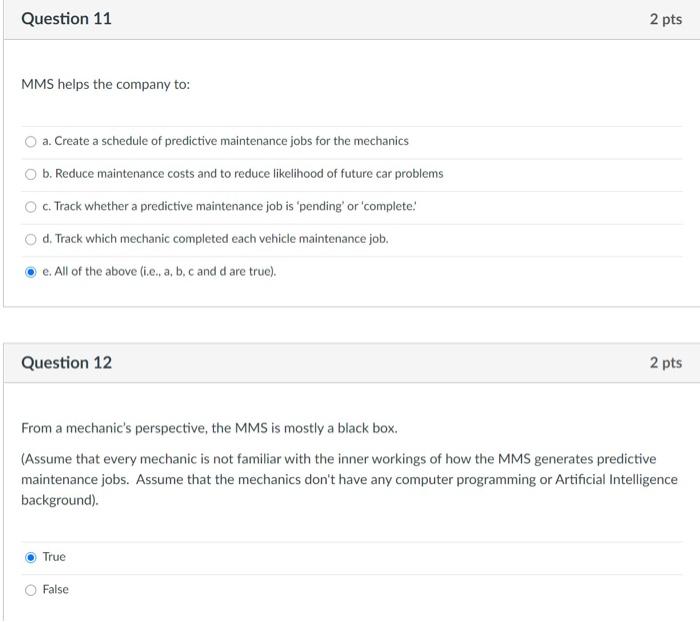
The business process example starts witha customer filing an online complaint regarding problems with a car that they rented in the past. The customer uses a Web-based system called Online Rental Interface (ORI) and submits a complaint form (online). Each morning, the Assistant Manager prints a hard copy of the complaint forms received the previous business day. (S)he then places that complaint form in a box for later processing, together with other complaint forms. (Paragraph 1) Each day at 11 a.m., the Assistant Manager of the rental company reviews every complaint form printed that morning, using a manual containing several rules for reviewing complaints. Those rules had been devised so that certain complaints could be filtered out (e.g., complaints not related to car maintenance problems) before they progressed any further in the business process. (Paragraph 2) The Assistant Manager meets with the Manager every day at 2 p.m., and hand delivers each reviewed complaint form to the Manager and informs the Manager about any complaints that need additional review by the Manager. The rental company's Manager reviews the complaint form only if the Assistant Manager recommends such a review. This additional review is completed by the Manager by end of the next business day and the Manager's reviews are shared with the Assistant Manager. (Paragraph 3) The rental company's Manager meets with the Maintenance Manager every day at 3 p.m., and hand-delivers each reviewed complaint form. The Maintenance Manager is the main point of contact in the company's maintenance department, which is the organizational unit that processes reviewed customer complaints. The Maintenance Manager does not review the complaint forms. (Paragraph 4) The Maintenance Manager then, upon receipt of a reviewed complaint form, places the form in a box for processing by the Computer Data Entry Staff (CDES). The CDES inputs the data into a software system called the Maintenance Management Software (MMS). (Paragraph 5) The MMS costs the rental company approximately $150,000. It incorporates artificial intelligence algorithms that operate on predictive maintenance rules. The algorithms allow the MMS to create a schedule of predictive maintenance activities (called 'jobs'). Completing these jobs reduces maintenance costs to a minimum while also reducing the likelihood of future car problems occurring while the cars are with the customers of the car rental company. Each 'job' has a 'pending' status when the 'job' is yet to be completed. The algorithm rules of MMS are dynamically and automatically updated based on: (a) each new complaint processed through the system and (b) details about completed predictive maintenance activities. Since the algorithm rules of MMS are dynamically and automatically updated, even if the same complaint is input into MMS on two different days, the order and number of jobs' generated by MMS can vary from day to day. (Paragraph 6) As mentioned earlier in paragraph 5, the CDES inputs data from the complaint form into MMS. Then, MMS generates the schedule of predictive maintenance 'jobs. The CDES then logs into the MMS and prints the jobs as a set of pages (one page per job). These jobs are organized according to the order of execution prescribed by MMS. The mechanic collects the printouts of the predictive maintenance jobs. (Paragraph 7) The CDES then places those pages in a box. The box is located at the entrance of the workshop used by the mechanics in the maintenance department. (Paragraph 8) A team of mechanics then processes each predictive maintenance job generated by MMS. Upon completion of each job, a mechanic who worked on the job accesses the MMS software using their login ID and password. The mechanic then enters details about each completed job in the MMS. These details include the name of the mechanic who completed the job and the time of job completion. (Paragraph 9). The MMS then automatically changes the status of the job' from 'pending' to 'completed, and keeps track of when the job was completed by which mechanic. At the end of each month, the MMS generates a report of predictive maintenance jobs that were completed. (Paragraph 10) For the first set of questions, read the scenario. Also, assume that a customer files a complaint regarding the break-down of a car they rented. Recall that in the Systems Theory chapter in this section of BA270, system components are considered elements if they: 1. Are a part of the system. 2. Are capable of adding value. (The value added must be beyond data storage or printing. The value added must be beyond storing data in digital or hard copy format.) 3. Can act on their own. (Sometimes they may need an input trigger to start their action.) Question 1 2 pts The following is (are) element(s) of the system described in the scenario. a. Manual b. Customer who filed the complaint C. Assistant Manager O b and c a, b and c. Question 2 2 pts The following is (are) element(s) of the system described in the scenario. a. Manager O b. Computer Data Entry Staff (CDES) c. Box (in which complaints form are placed) a, b and c. a and b, but not c. Question 3 2 pts The following is (are) not element(s) of the system described in the scenario. a. Mechanic b. Complaint form O C. MMS d. Maintenance Manager All of the above (i.e., a, b. c and d are not elements). Question 4 2 pts From a CDES's perspective, the MMS is a black box. (Assume that every CDES is not familiar with the inner workings of how the MMs generates predictive maintenance jobs. Assume that the CDESS don't have any computer programming or Artificial Intelligence background. However, they know how to input data into the MMS). True False Note: Explaining a definition with an illuminating example. We defined 'feedback' (using Systems Theory description) as follows: "An input to an element as a response to a previous output by the same element." In applying this definition to paragraph 7 of the scenario, we can conclude that paragraph 7 includes an illuminating example of a 'feedback' as per the justification below. Justification: Element under consideration = CDES Step 1: Output done by element CDES = Manually enter complaint into MMS Step 2: Input to element CDES as a result of previous output done by CDES in Step 1 = Receive printouts of jobs schedule. Question 5 2 pts Paragraph 3 of the scenario includes an illuminating example of a 'feedback! True False Question 6 2 pts Paragraph 4 of the scenario includes an illuminating example of a 'feedback' True False Question 7 2 pts Together, paragraphs 4 and 5 of the scenario include an illuminating example of a 'feedback'. True False Question 8 2 pts Paragraph 9 of the scenario includes an illuminating example of a 'feedback'. True False Make the following assumptions about paragraph 3 for the next question. Initial State: Assistant Manager and Manager meet every day as scheduled. System Behavior: Assistant Manager hand-delivers reviewed complaints to Manager, and informs Manager about complaints that need additional review. Output: the number of complaints that need additional review. Question 9 2 pts Based on the above stated assumptions, paragraph 3 represents an illuminating example of a 'deterministic' process. True False Refer to paragraphs 6 and 7 of the scenario. Make the following assumptions for the next question. Initial State: CDES inputs complaints into MMS. System Behavior: MMS generates a schedule of predictive maintenance jobs. Output: The order of jobs generated. Question 10 2 pts The above-stated assumptions and the last sentence of paragraph 6 illuminate that the process used by MMS to generate the order of jobs is a 'stochastic' process. True O False Question 11 2 pts MMS helps the company to: O a. Create a schedule of predictive maintenance jobs for the mechanics O b. Reduce maintenance costs and to reduce likelihood of future car problems O . Track whether a predictive maintenance job is 'pending' or 'complete! d. Track which mechanic completed each vehicle maintenance job. e. All of the above (i.e., a, b, c and d are true). Question 12 2 pts From a mechanic's perspective, the MMS is mostly a black box. (Assume that every mechanic is not familiar with the inner workings of how the MMS generates predictive maintenance jobs. Assume that the mechanics don't have any computer programming or Artificial Intelligence background). True False The business process example starts witha customer filing an online complaint regarding problems with a car that they rented in the past. The customer uses a Web-based system called Online Rental Interface (ORI) and submits a complaint form (online). Each morning, the Assistant Manager prints a hard copy of the complaint forms received the previous business day. (S)he then places that complaint form in a box for later processing, together with other complaint forms. (Paragraph 1) Each day at 11 a.m., the Assistant Manager of the rental company reviews every complaint form printed that morning, using a manual containing several rules for reviewing complaints. Those rules had been devised so that certain complaints could be filtered out (e.g., complaints not related to car maintenance problems) before they progressed any further in the business process. (Paragraph 2) The Assistant Manager meets with the Manager every day at 2 p.m., and hand delivers each reviewed complaint form to the Manager and informs the Manager about any complaints that need additional review by the Manager. The rental company's Manager reviews the complaint form only if the Assistant Manager recommends such a review. This additional review is completed by the Manager by end of the next business day and the Manager's reviews are shared with the Assistant Manager. (Paragraph 3) The rental company's Manager meets with the Maintenance Manager every day at 3 p.m., and hand-delivers each reviewed complaint form. The Maintenance Manager is the main point of contact in the company's maintenance department, which is the organizational unit that processes reviewed customer complaints. The Maintenance Manager does not review the complaint forms. (Paragraph 4) The Maintenance Manager then, upon receipt of a reviewed complaint form, places the form in a box for processing by the Computer Data Entry Staff (CDES). The CDES inputs the data into a software system called the Maintenance Management Software (MMS). (Paragraph 5) The MMS costs the rental company approximately $150,000. It incorporates artificial intelligence algorithms that operate on predictive maintenance rules. The algorithms allow the MMS to create a schedule of predictive maintenance activities (called 'jobs'). Completing these jobs reduces maintenance costs to a minimum while also reducing the likelihood of future car problems occurring while the cars are with the customers of the car rental company. Each 'job' has a 'pending' status when the 'job' is yet to be completed. The algorithm rules of MMS are dynamically and automatically updated based on: (a) each new complaint processed through the system and (b) details about completed predictive maintenance activities. Since the algorithm rules of MMS are dynamically and automatically updated, even if the same complaint is input into MMS on two different days, the order and number of jobs' generated by MMS can vary from day to day. (Paragraph 6) As mentioned earlier in paragraph 5, the CDES inputs data from the complaint form into MMS. Then, MMS generates the schedule of predictive maintenance 'jobs. The CDES then logs into the MMS and prints the jobs as a set of pages (one page per job). These jobs are organized according to the order of execution prescribed by MMS. The mechanic collects the printouts of the predictive maintenance jobs. (Paragraph 7) The CDES then places those pages in a box. The box is located at the entrance of the workshop used by the mechanics in the maintenance department. (Paragraph 8) A team of mechanics then processes each predictive maintenance job generated by MMS. Upon completion of each job, a mechanic who worked on the job accesses the MMS software using their login ID and password. The mechanic then enters details about each completed job in the MMS. These details include the name of the mechanic who completed the job and the time of job completion. (Paragraph 9). The MMS then automatically changes the status of the job' from 'pending' to 'completed, and keeps track of when the job was completed by which mechanic. At the end of each month, the MMS generates a report of predictive maintenance jobs that were completed. (Paragraph 10) For the first set of questions, read the scenario. Also, assume that a customer files a complaint regarding the break-down of a car they rented. Recall that in the Systems Theory chapter in this section of BA270, system components are considered elements if they: 1. Are a part of the system. 2. Are capable of adding value. (The value added must be beyond data storage or printing. The value added must be beyond storing data in digital or hard copy format.) 3. Can act on their own. (Sometimes they may need an input trigger to start their action.) Question 1 2 pts The following is (are) element(s) of the system described in the scenario. a. Manual b. Customer who filed the complaint C. Assistant Manager O b and c a, b and c. Question 2 2 pts The following is (are) element(s) of the system described in the scenario. a. Manager O b. Computer Data Entry Staff (CDES) c. Box (in which complaints form are placed) a, b and c. a and b, but not c. Question 3 2 pts The following is (are) not element(s) of the system described in the scenario. a. Mechanic b. Complaint form O C. MMS d. Maintenance Manager All of the above (i.e., a, b. c and d are not elements). Question 4 2 pts From a CDES's perspective, the MMS is a black box. (Assume that every CDES is not familiar with the inner workings of how the MMs generates predictive maintenance jobs. Assume that the CDESS don't have any computer programming or Artificial Intelligence background. However, they know how to input data into the MMS). True False Note: Explaining a definition with an illuminating example. We defined 'feedback' (using Systems Theory description) as follows: "An input to an element as a response to a previous output by the same element." In applying this definition to paragraph 7 of the scenario, we can conclude that paragraph 7 includes an illuminating example of a 'feedback' as per the justification below. Justification: Element under consideration = CDES Step 1: Output done by element CDES = Manually enter complaint into MMS Step 2: Input to element CDES as a result of previous output done by CDES in Step 1 = Receive printouts of jobs schedule. Question 5 2 pts Paragraph 3 of the scenario includes an illuminating example of a 'feedback! True False Question 6 2 pts Paragraph 4 of the scenario includes an illuminating example of a 'feedback' True False Question 7 2 pts Together, paragraphs 4 and 5 of the scenario include an illuminating example of a 'feedback'. True False Question 8 2 pts Paragraph 9 of the scenario includes an illuminating example of a 'feedback'. True False Make the following assumptions about paragraph 3 for the next question. Initial State: Assistant Manager and Manager meet every day as scheduled. System Behavior: Assistant Manager hand-delivers reviewed complaints to Manager, and informs Manager about complaints that need additional review. Output: the number of complaints that need additional review. Question 9 2 pts Based on the above stated assumptions, paragraph 3 represents an illuminating example of a 'deterministic' process. True False Refer to paragraphs 6 and 7 of the scenario. Make the following assumptions for the next question. Initial State: CDES inputs complaints into MMS. System Behavior: MMS generates a schedule of predictive maintenance jobs. Output: The order of jobs generated. Question 10 2 pts The above-stated assumptions and the last sentence of paragraph 6 illuminate that the process used by MMS to generate the order of jobs is a 'stochastic' process. True O False Question 11 2 pts MMS helps the company to: O a. Create a schedule of predictive maintenance jobs for the mechanics O b. Reduce maintenance costs and to reduce likelihood of future car problems O . Track whether a predictive maintenance job is 'pending' or 'complete! d. Track which mechanic completed each vehicle maintenance job. e. All of the above (i.e., a, b, c and d are true). Question 12 2 pts From a mechanic's perspective, the MMS is mostly a black box. (Assume that every mechanic is not familiar with the inner workings of how the MMS generates predictive maintenance jobs. Assume that the mechanics don't have any computer programming or Artificial Intelligence background). True False The business process example starts witha customer filing an online complaint regarding problems with a car that they rented in the past. The customer uses a Web-based system called Online Rental Interface (ORI) and submits a complaint form (online). Each morning, the Assistant Manager prints a hard copy of the complaint forms received the previous business day. (S)he then places that complaint form in a box for later processing, together with other complaint forms. (Paragraph 1) Each day at 11 a.m., the Assistant Manager of the rental company reviews every complaint form printed that morning, using a manual containing several rules for reviewing complaints. Those rules had been devised so that certain complaints could be filtered out (e.g., complaints not related to car maintenance problems) before they progressed any further in the business process. (Paragraph 2) The Assistant Manager meets with the Manager every day at 2 p.m., and hand delivers each reviewed complaint form to the Manager and informs the Manager about any complaints that need additional review by the Manager. The rental company's Manager reviews the complaint form only if the Assistant Manager recommends such a review. This additional review is completed by the Manager by end of the next business day and the Manager's reviews are shared with the Assistant Manager. (Paragraph 3) The rental company's Manager meets with the Maintenance Manager every day at 3 p.m., and hand-delivers each reviewed complaint form. The Maintenance Manager is the main point of contact in the company's maintenance department, which is the organizational unit that processes reviewed customer complaints. The Maintenance Manager does not review the complaint forms. (Paragraph 4) The Maintenance Manager then, upon receipt of a reviewed complaint form, places the form in a box for processing by the Computer Data Entry Staff (CDES). The CDES inputs the data into a software system called the Maintenance Management Software (MMS). (Paragraph 5) The MMS costs the rental company approximately $150,000. It incorporates artificial intelligence algorithms that operate on predictive maintenance rules. The algorithms allow the MMS to create a schedule of predictive maintenance activities (called 'jobs'). Completing these jobs reduces maintenance costs to a minimum while also reducing the likelihood of future car problems occurring while the cars are with the customers of the car rental company. Each 'job' has a 'pending' status when the 'job' is yet to be completed. The algorithm rules of MMS are dynamically and automatically updated based on: (a) each new complaint processed through the system and (b) details about completed predictive maintenance activities. Since the algorithm rules of MMS are dynamically and automatically updated, even if the same complaint is input into MMS on two different days, the order and number of jobs' generated by MMS can vary from day to day. (Paragraph 6) As mentioned earlier in paragraph 5, the CDES inputs data from the complaint form into MMS. Then, MMS generates the schedule of predictive maintenance 'jobs. The CDES then logs into the MMS and prints the jobs as a set of pages (one page per job). These jobs are organized according to the order of execution prescribed by MMS. The mechanic collects the printouts of the predictive maintenance jobs. (Paragraph 7) The CDES then places those pages in a box. The box is located at the entrance of the workshop used by the mechanics in the maintenance department. (Paragraph 8) A team of mechanics then processes each predictive maintenance job generated by MMS. Upon completion of each job, a mechanic who worked on the job accesses the MMS software using their login ID and password. The mechanic then enters details about each completed job in the MMS. These details include the name of the mechanic who completed the job and the time of job completion. (Paragraph 9). The MMS then automatically changes the status of the job' from 'pending' to 'completed, and keeps track of when the job was completed by which mechanic. At the end of each month, the MMS generates a report of predictive maintenance jobs that were completed. (Paragraph 10) For the first set of questions, read the scenario. Also, assume that a customer files a complaint regarding the break-down of a car they rented. Recall that in the Systems Theory chapter in this section of BA270, system components are considered elements if they: 1. Are a part of the system. 2. Are capable of adding value. (The value added must be beyond data storage or printing. The value added must be beyond storing data in digital or hard copy format.) 3. Can act on their own. (Sometimes they may need an input trigger to start their action.) Question 1 2 pts The following is (are) element(s) of the system described in the scenario. a. Manual b. Customer who filed the complaint C. Assistant Manager O b and c a, b and c. Question 2 2 pts The following is (are) element(s) of the system described in the scenario. a. Manager O b. Computer Data Entry Staff (CDES) c. Box (in which complaints form are placed) a, b and c. a and b, but not c. Question 3 2 pts The following is (are) not element(s) of the system described in the scenario. a. Mechanic b. Complaint form O C. MMS d. Maintenance Manager All of the above (i.e., a, b. c and d are not elements). Question 4 2 pts From a CDES's perspective, the MMS is a black box. (Assume that every CDES is not familiar with the inner workings of how the MMs generates predictive maintenance jobs. Assume that the CDESS don't have any computer programming or Artificial Intelligence background. However, they know how to input data into the MMS). True False Note: Explaining a definition with an illuminating example. We defined 'feedback' (using Systems Theory description) as follows: "An input to an element as a response to a previous output by the same element." In applying this definition to paragraph 7 of the scenario, we can conclude that paragraph 7 includes an illuminating example of a 'feedback' as per the justification below. Justification: Element under consideration = CDES Step 1: Output done by element CDES = Manually enter complaint into MMS Step 2: Input to element CDES as a result of previous output done by CDES in Step 1 = Receive printouts of jobs schedule. Question 5 2 pts Paragraph 3 of the scenario includes an illuminating example of a 'feedback! True False Question 6 2 pts Paragraph 4 of the scenario includes an illuminating example of a 'feedback' True False Question 7 2 pts Together, paragraphs 4 and 5 of the scenario include an illuminating example of a 'feedback'. True False Question 8 2 pts Paragraph 9 of the scenario includes an illuminating example of a 'feedback'. True False Make the following assumptions about paragraph 3 for the next question. Initial State: Assistant Manager and Manager meet every day as scheduled. System Behavior: Assistant Manager hand-delivers reviewed complaints to Manager, and informs Manager about complaints that need additional review. Output: the number of complaints that need additional review. Question 9 2 pts Based on the above stated assumptions, paragraph 3 represents an illuminating example of a 'deterministic' process. True False Refer to paragraphs 6 and 7 of the scenario. Make the following assumptions for the next question. Initial State: CDES inputs complaints into MMS. System Behavior: MMS generates a schedule of predictive maintenance jobs. Output: The order of jobs generated. Question 10 2 pts The above-stated assumptions and the last sentence of paragraph 6 illuminate that the process used by MMS to generate the order of jobs is a 'stochastic' process. True O False Question 11 2 pts MMS helps the company to: O a. Create a schedule of predictive maintenance jobs for the mechanics O b. Reduce maintenance costs and to reduce likelihood of future car problems O . Track whether a predictive maintenance job is 'pending' or 'complete! d. Track which mechanic completed each vehicle maintenance job. e. All of the above (i.e., a, b, c and d are true). Question 12 2 pts From a mechanic's perspective, the MMS is mostly a black box. (Assume that every mechanic is not familiar with the inner workings of how the MMS generates predictive maintenance jobs. Assume that the mechanics don't have any computer programming or Artificial Intelligence background). True False The business process example starts witha customer filing an online complaint regarding problems with a car that they rented in the past. The customer uses a Web-based system called Online Rental Interface (ORI) and submits a complaint form (online). Each morning, the Assistant Manager prints a hard copy of the complaint forms received the previous business day. (S)he then places that complaint form in a box for later processing, together with other complaint forms. (Paragraph 1) Each day at 11 a.m., the Assistant Manager of the rental company reviews every complaint form printed that morning, using a manual containing several rules for reviewing complaints. Those rules had been devised so that certain complaints could be filtered out (e.g., complaints not related to car maintenance problems) before they progressed any further in the business process. (Paragraph 2) The Assistant Manager meets with the Manager every day at 2 p.m., and hand delivers each reviewed complaint form to the Manager and informs the Manager about any complaints that need additional review by the Manager. The rental company's Manager reviews the complaint form only if the Assistant Manager recommends such a review. This additional review is completed by the Manager by end of the next business day and the Manager's reviews are shared with the Assistant Manager. (Paragraph 3) The rental company's Manager meets with the Maintenance Manager every day at 3 p.m., and hand-delivers each reviewed complaint form. The Maintenance Manager is the main point of contact in the company's maintenance department, which is the organizational unit that processes reviewed customer complaints. The Maintenance Manager does not review the complaint forms. (Paragraph 4) The Maintenance Manager then, upon receipt of a reviewed complaint form, places the form in a box for processing by the Computer Data Entry Staff (CDES). The CDES inputs the data into a software system called the Maintenance Management Software (MMS). (Paragraph 5) The MMS costs the rental company approximately $150,000. It incorporates artificial intelligence algorithms that operate on predictive maintenance rules. The algorithms allow the MMS to create a schedule of predictive maintenance activities (called 'jobs'). Completing these jobs reduces maintenance costs to a minimum while also reducing the likelihood of future car problems occurring while the cars are with the customers of the car rental company. Each 'job' has a 'pending' status when the 'job' is yet to be completed. The algorithm rules of MMS are dynamically and automatically updated based on: (a) each new complaint processed through the system and (b) details about completed predictive maintenance activities. Since the algorithm rules of MMS are dynamically and automatically updated, even if the same complaint is input into MMS on two different days, the order and number of jobs' generated by MMS can vary from day to day. (Paragraph 6) As mentioned earlier in paragraph 5, the CDES inputs data from the complaint form into MMS. Then, MMS generates the schedule of predictive maintenance 'jobs. The CDES then logs into the MMS and prints the jobs as a set of pages (one page per job). These jobs are organized according to the order of execution prescribed by MMS. The mechanic collects the printouts of the predictive maintenance jobs. (Paragraph 7) The CDES then places those pages in a box. The box is located at the entrance of the workshop used by the mechanics in the maintenance department. (Paragraph 8) A team of mechanics then processes each predictive maintenance job generated by MMS. Upon completion of each job, a mechanic who worked on the job accesses the MMS software using their login ID and password. The mechanic then enters details about each completed job in the MMS. These details include the name of the mechanic who completed the job and the time of job completion. (Paragraph 9). The MMS then automatically changes the status of the job' from 'pending' to 'completed, and keeps track of when the job was completed by which mechanic. At the end of each month, the MMS generates a report of predictive maintenance jobs that were completed. (Paragraph 10) For the first set of questions, read the scenario. Also, assume that a customer files a complaint regarding the break-down of a car they rented. Recall that in the Systems Theory chapter in this section of BA270, system components are considered elements if they: 1. Are a part of the system. 2. Are capable of adding value. (The value added must be beyond data storage or printing. The value added must be beyond storing data in digital or hard copy format.) 3. Can act on their own. (Sometimes they may need an input trigger to start their action.) Question 1 2 pts The following is (are) element(s) of the system described in the scenario. a. Manual b. Customer who filed the complaint C. Assistant Manager O b and c a, b and c. Question 2 2 pts The following is (are) element(s) of the system described in the scenario. a. Manager O b. Computer Data Entry Staff (CDES) c. Box (in which complaints form are placed) a, b and c. a and b, but not c. Question 3 2 pts The following is (are) not element(s) of the system described in the scenario. a. Mechanic b. Complaint form O C. MMS d. Maintenance Manager All of the above (i.e., a, b. c and d are not elements). Question 4 2 pts From a CDES's perspective, the MMS is a black box. (Assume that every CDES is not familiar with the inner workings of how the MMs generates predictive maintenance jobs. Assume that the CDESS don't have any computer programming or Artificial Intelligence background. However, they know how to input data into the MMS). True False Note: Explaining a definition with an illuminating example. We defined 'feedback' (using Systems Theory description) as follows: "An input to an element as a response to a previous output by the same element." In applying this definition to paragraph 7 of the scenario, we can conclude that paragraph 7 includes an illuminating example of a 'feedback' as per the justification below. Justification: Element under consideration = CDES Step 1: Output done by element CDES = Manually enter complaint into MMS Step 2: Input to element CDES as a result of previous output done by CDES in Step 1 = Receive printouts of jobs schedule. Question 5 2 pts Paragraph 3 of the scenario includes an illuminating example of a 'feedback! True False Question 6 2 pts Paragraph 4 of the scenario includes an illuminating example of a 'feedback' True False Question 7 2 pts Together, paragraphs 4 and 5 of the scenario include an illuminating example of a 'feedback'. True False Question 8 2 pts Paragraph 9 of the scenario includes an illuminating example of a 'feedback'. True False Make the following assumptions about paragraph 3 for the next question. Initial State: Assistant Manager and Manager meet every day as scheduled. System Behavior: Assistant Manager hand-delivers reviewed complaints to Manager, and informs Manager about complaints that need additional review. Output: the number of complaints that need additional review. Question 9 2 pts Based on the above stated assumptions, paragraph 3 represents an illuminating example of a 'deterministic' process. True False Refer to paragraphs 6 and 7 of the scenario. Make the following assumptions for the next question. Initial State: CDES inputs complaints into MMS. System Behavior: MMS generates a schedule of predictive maintenance jobs. Output: The order of jobs generated. Question 10 2 pts The above-stated assumptions and the last sentence of paragraph 6 illuminate that the process used by MMS to generate the order of jobs is a 'stochastic' process. True O False Question 11 2 pts MMS helps the company to: O a. Create a schedule of predictive maintenance jobs for the mechanics O b. Reduce maintenance costs and to reduce likelihood of future car problems O . Track whether a predictive maintenance job is 'pending' or 'complete! d. Track which mechanic completed each vehicle maintenance job. e. All of the above (i.e., a, b, c and d are true). Question 12 2 pts From a mechanic's perspective, the MMS is mostly a black box. (Assume that every mechanic is not familiar with the inner workings of how the MMS generates predictive maintenance jobs. Assume that the mechanics don't have any computer programming or Artificial Intelligence background). True False The business process example starts witha customer filing an online complaint regarding problems with a car that they rented in the past. The customer uses a Web-based system called Online Rental Interface (ORI) and submits a complaint form (online). Each morning, the Assistant Manager prints a hard copy of the complaint forms received the previous business day. (S)he then places that complaint form in a box for later processing, together with other complaint forms. (Paragraph 1) Each day at 11 a.m., the Assistant Manager of the rental company reviews every complaint form printed that morning, using a manual containing several rules for reviewing complaints. Those rules had been devised so that certain complaints could be filtered out (e.g., complaints not related to car maintenance problems) before they progressed any further in the business process. (Paragraph 2) The Assistant Manager meets with the Manager every day at 2 p.m., and hand delivers each reviewed complaint form to the Manager and informs the Manager about any complaints that need additional review by the Manager. The rental company's Manager reviews the complaint form only if the Assistant Manager recommends such a review. This additional review is completed by the Manager by end of the next business day and the Manager's reviews are shared with the Assistant Manager. (Paragraph 3) The rental company's Manager meets with the Maintenance Manager every day at 3 p.m., and hand-delivers each reviewed complaint form. The Maintenance Manager is the main point of contact in the company's maintenance department, which is the organizational unit that processes reviewed customer complaints. The Maintenance Manager does not review the complaint forms. (Paragraph 4) The Maintenance Manager then, upon receipt of a reviewed complaint form, places the form in a box for processing by the Computer Data Entry Staff (CDES). The CDES inputs the data into a software system called the Maintenance Management Software (MMS). (Paragraph 5) The MMS costs the rental company approximately $150,000. It incorporates artificial intelligence algorithms that operate on predictive maintenance rules. The algorithms allow the MMS to create a schedule of predictive maintenance activities (called 'jobs'). Completing these jobs reduces maintenance costs to a minimum while also reducing the likelihood of future car problems occurring while the cars are with the customers of the car rental company. Each 'job' has a 'pending' status when the 'job' is yet to be completed. The algorithm rules of MMS are dynamically and automatically updated based on: (a) each new complaint processed through the system and (b) details about completed predictive maintenance activities. Since the algorithm rules of MMS are dynamically and automatically updated, even if the same complaint is input into MMS on two different days, the order and number of jobs' generated by MMS can vary from day to day. (Paragraph 6) As mentioned earlier in paragraph 5, the CDES inputs data from the complaint form into MMS. Then, MMS generates the schedule of predictive maintenance 'jobs. The CDES then logs into the MMS and prints the jobs as a set of pages (one page per job). These jobs are organized according to the order of execution prescribed by MMS. The mechanic collects the printouts of the predictive maintenance jobs. (Paragraph 7) The CDES then places those pages in a box. The box is located at the entrance of the workshop used by the mechanics in the maintenance department. (Paragraph 8) A team of mechanics then processes each predictive maintenance job generated by MMS. Upon completion of each job, a mechanic who worked on the job accesses the MMS software using their login ID and password. The mechanic then enters details about each completed job in the MMS. These details include the name of the mechanic who completed the job and the time of job completion. (Paragraph 9). The MMS then automatically changes the status of the job' from 'pending' to 'completed, and keeps track of when the job was completed by which mechanic. At the end of each month, the MMS generates a report of predictive maintenance jobs that were completed. (Paragraph 10) For the first set of questions, read the scenario. Also, assume that a customer files a complaint regarding the break-down of a car they rented. Recall that in the Systems Theory chapter in this section of BA270, system components are considered elements if they: 1. Are a part of the system. 2. Are capable of adding value. (The value added must be beyond data storage or printing. The value added must be beyond storing data in digital or hard copy format.) 3. Can act on their own. (Sometimes they may need an input trigger to start their action.) Question 1 2 pts The following is (are) element(s) of the system described in the scenario. a. Manual b. Customer who filed the complaint C. Assistant Manager O b and c a, b and c. Question 2 2 pts The following is (are) element(s) of the system described in the scenario. a. Manager O b. Computer Data Entry Staff (CDES) c. Box (in which complaints form are placed) a, b and c. a and b, but not c. Question 3 2 pts The following is (are) not element(s) of the system described in the scenario. a. Mechanic b. Complaint form O C. MMS d. Maintenance Manager All of the above (i.e., a, b. c and d are not elements). Question 4 2 pts From a CDES's perspective, the MMS is a black box. (Assume that every CDES is not familiar with the inner workings of how the MMs generates predictive maintenance jobs. Assume that the CDESS don't have any computer programming or Artificial Intelligence background. However, they know how to input data into the MMS). True False Note: Explaining a definition with an illuminating example. We defined 'feedback' (using Systems Theory description) as follows: "An input to an element as a response to a previous output by the same element." In applying this definition to paragraph 7 of the scenario, we can conclude that paragraph 7 includes an illuminating example of a 'feedback' as per the justification below. Justification: Element under consideration = CDES Step 1: Output done by element CDES = Manually enter complaint into MMS Step 2: Input to element CDES as a result of previous output done by CDES in Step 1 = Receive printouts of jobs schedule. Question 5 2 pts Paragraph 3 of the scenario includes an illuminating example of a 'feedback! True False Question 6 2 pts Paragraph 4 of the scenario includes an illuminating example of a 'feedback' True False Question 7 2 pts Together, paragraphs 4 and 5 of the scenario include an illuminating example of a 'feedback'. True False Question 8 2 pts Paragraph 9 of the scenario includes an illuminating example of a 'feedback'. True False Make the following assumptions about paragraph 3 for the next question. Initial State: Assistant Manager and Manager meet every day as scheduled. System Behavior: Assistant Manager hand-delivers reviewed complaints to Manager, and informs Manager about complaints that need additional review. Output: the number of complaints that need additional review. Question 9 2 pts Based on the above stated assumptions, paragraph 3 represents an illuminating example of a 'deterministic' process. True False Refer to paragraphs 6 and 7 of the scenario. Make the following assumptions for the next question. Initial State: CDES inputs complaints into MMS. System Behavior: MMS generates a schedule of predictive maintenance jobs. Output: The order of jobs generated. Question 10 2 pts The above-stated assumptions and the last sentence of paragraph 6 illuminate that the process used by MMS to generate the order of jobs is a 'stochastic' process. True O False Question 11 2 pts MMS helps the company to: O a. Create a schedule of predictive maintenance jobs for the mechanics O b. Reduce maintenance costs and to reduce likelihood of future car problems O . Track whether a predictive maintenance job is 'pending' or 'complete! d. Track which mechanic completed each vehicle maintenance job. e. All of the above (i.e., a, b, c and d are true). Question 12 2 pts From a mechanic's perspective, the MMS is mostly a black box. (Assume that every mechanic is not familiar with the inner workings of how the MMS generates predictive maintenance jobs. Assume that the mechanics don't have any computer programming or Artificial Intelligence background). True False
Step by Step Solution
There are 3 Steps involved in it
Step: 1
1 Correct option d b and c Reason As per the case the customer filed the complaint online and the as...
Get Instant Access to Expert-Tailored Solutions
See step-by-step solutions with expert insights and AI powered tools for academic success
Step: 2

Step: 3

Ace Your Homework with AI
Get the answers you need in no time with our AI-driven, step-by-step assistance
Get Started


